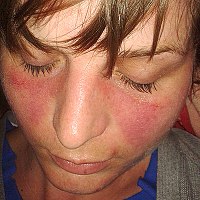
Photo from wikipedia
Background Systemic Lupus Erythematous (SLE) is an autoimmune disease that is known to cause many cardiac complications including lesions of the valves, myocardium, pericardium, and the coronary vessel. However, the… Click to show full abstract
Background Systemic Lupus Erythematous (SLE) is an autoimmune disease that is known to cause many cardiac complications including lesions of the valves, myocardium, pericardium, and the coronary vessel. However, the management of SLE induced cardiomyopathy remains controversial. Case presentation A 59-year-old African American woman with a medical history of hypertension presented with dyspnea on exertion for a few days. Physical exam revealed distended neck vein, lung crackles, and leg swelling. EKG showed normal sinus rhythm. Transthoracic echocardiogram (TTE) showed a left ventricular ejection fraction of 10% (LVEF). Decision-making The patient was treated with intravenous diuretic and improved symptomatically. She underwent a coronary angiogram, which showed normal coronary arteries and cardiac MRI didn't reveal any signs of myocarditis or infiltrative cardiomyopathy. We started guideline-directed medical therapy (GDMT) including losartan, carvedilol, and spironolactone, and titrated up accordingly. In a follow-up echocardiogram after 3 months, LVEF remained unchanged while on optimal GDMT. She developed a skin rash with fatigue and further investigations showed evidence of SLE. With the presence of heart failure and newly diagnosed SLE, the underlying cause of cardiomyopathy was most likely due to SLE. At this point, we were perplexed on how to approach SLE related cardiomyopathy and decided to treat underlying autoimmune disease with rituximab, hydroxychloroquine, and methylprednisolone. A follow-up TTE in a month disclosed LVEF of 40-45%. Conclusion The role of GDMT is unclear in SLE induced cardiomyopathy and has never been tested in randomized trials. However, treatment of SLE with immunomodulating therapies could ameliorate and even reverse the cardiomyopathy, which was demonstrated in our case. Early recognition of SLE and aggressive intervention is paramount for recovery in SLE related cardiomyopathy.
Journal Title: Journal of Cardiac Failure
Year Published: 2020
Link to full text (if available)
Share on Social Media: Sign Up to like & get
recommendations!